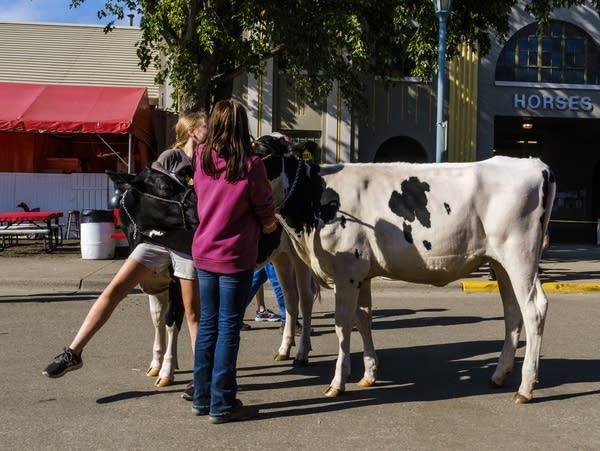Infrequently Asked Fair Questions: What happens to all the manure at the Minnesota State Fair?

Go Deeper.
Create an account or log in to save stories.
Like this?
Thanks for liking this story! We have added it to a list of your favorite stories.
For this year’s Minnesota State Fair, MPR’s All Things Considered will be featuring a series called “Infrequently Asked Questions.” MPR News reporters will try to answer fair questions you didn't know you had.
Hundreds of farm animals are shown every year at the Minnesota State Fair — and where you find farm animals, you know you’re going to find something else.
Manure. Lots and lots of manure.
How much? Where does it all go?
Turn Up Your Support
MPR News helps you turn down the noise and build shared understanding. Turn up your support for this public resource and keep trusted journalism accessible to all.
Well, for the next in what we’re calling our “Infrequently Asked Questions” series about the State Fair, we sent MPR News reporter Tim Nelson to find the answers. He joined host Tom Crann from beside the manure pit behind the Livestock Pavilion at the fair.

So, lets start with the basics, Tim: How does it smell?
It doesn’t really smell. The thing is, it isn’t all just poop. All these animals are provided fresh bedding, like wood shavings or straw, and they, well, defecate in it. And there’s no real point in trying to pick the poop out of the bedding, so it all just gets mixed together in the pit — even some waste milk gets dumped here.
I talked to Rachel Visser, from Hutchinson, who is showing some of her dairy cows here with 4-H.
“So we want all of our animals in the barn to be clean and stay clean throughout the fair, so when people are walking through they can see clean animals ... laying on clean bedding," she said. "So we shovel it all out ... and then into buckets and it all ends up in this wheelbarrow, and everybody comes and dumps it here,” she said.
And "here," Tom, is a giant pit about 30 feet long that slopes down to about eight feet deep at one end. It’s got an awning over it that kind of keeps out the sun and the rain. If it was in your backyard, you wouldn’t really notice the smell that much — in part because the manure and everything else gets hauled away constantly.

And just how much are we talking about here?
Well, Tom, we’re talking truckloads. Truckloads and truckloads and truckloads.
The company Minnesota Dirt Works has a contract with the fair to scoop out the pit with a skid loader, put all this excrement and bedding and whatnot into a dumpster and haul it away.
And just for scale, Tom, this is a 30-yard dumpster, about the size of a small school bus, and they haul about five or six of these away every day. And there’s another one of these big pits over behind the horse barn.
But there are also days when the animals in the barn change over — about every four days —and EVERYTHING is cleaned out of the barns.
That’s a pile of manure and bedding about two stories high that gets hauled away overnight. So this winds up being about 10,000 cubic yards of bedding and manure and urine and everything else for every fair.
And just to give you a sense of that, we’re talking about basically a football field piled four feet deep with animal waste.

And where does this all go?
It has gone many places. In the past it’s gone to Wisconsin, or to berry farmers, or to a recycling yard down by the river in St. Paul. They have to be very careful with it – and you’ll see signs all over outside the barns here, admonishing people not to let any trash into this, what they call compost. They don’t want plastic cups or food wrappers or stuff like that in the mix.
These days, the raw material goes to a company in Maple Grove, near the big gravel pit by the Arbor Lakes shopping area off of I-94. Minnesota Mulch takes this stuff, mixes it with other organics and they basically stir it and scoop it around for weeks until it turns into organic topsoil.
But don’t drive your Subaru up there to get yourself some actual Minnesota State Fair garden fill. They declined to talk to me about their product, but their website says they only sell in bulk, with a minimum 20 yard order, so it’s not like a boutique product or anything like that. We’re talking industrial scale.


